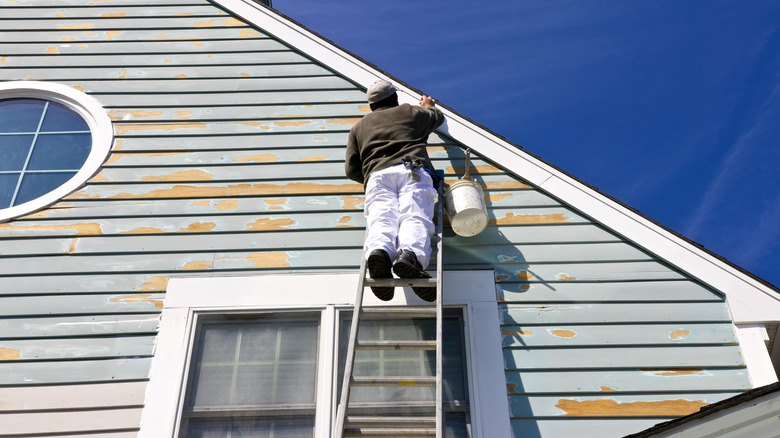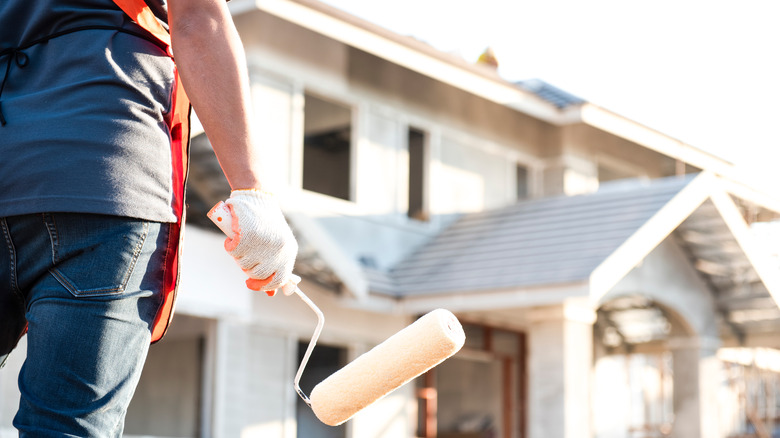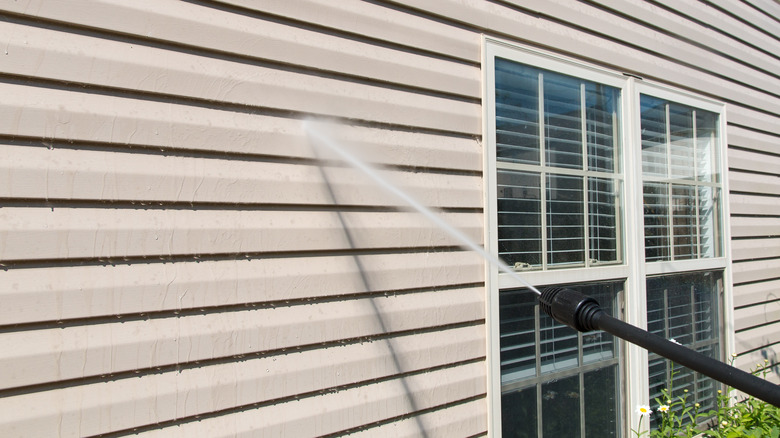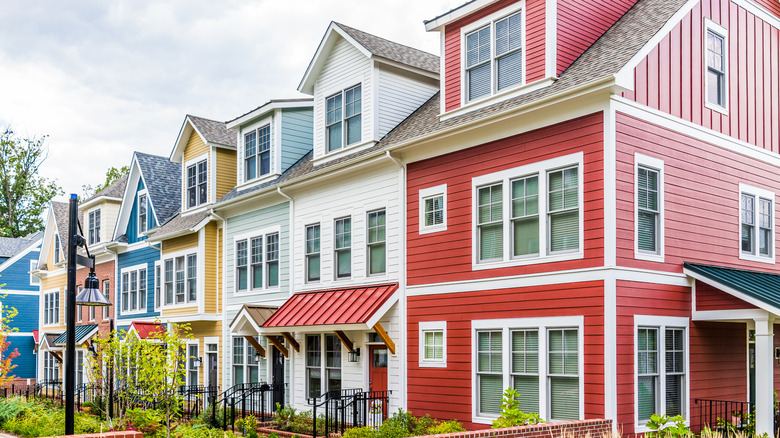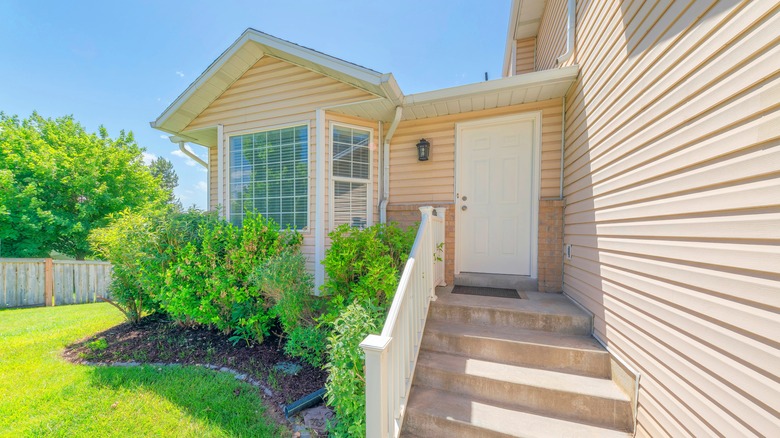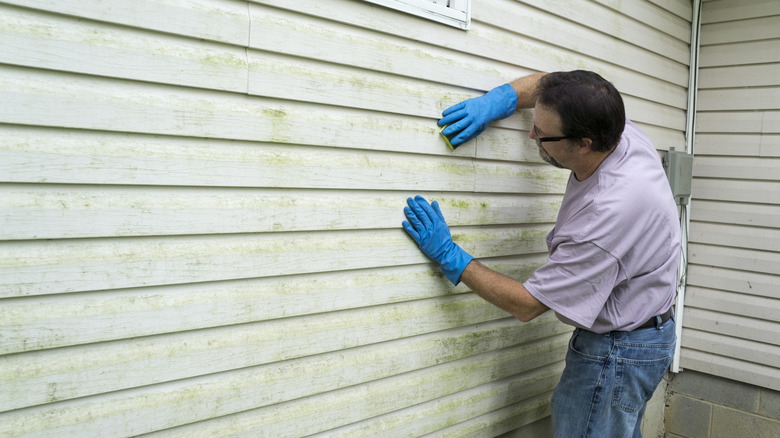Everything You Need To Know About Painting Your Vinyl Siding
Vinyl is an ideal choice if you want to achieve a beautiful home exterior. Modern vinyl siding comes in an array of designs you can pick from, not to mention it is budget-friendly and lasts longer than other similar materials. What most homeowners don't know is whether to paint vinyl or not. According to Insider, you can indeed paint your vinyl siding if the color no longer suits you or if you want to bring the old worn siding back to life.
Provided you have the right type of paint, vinyl can be brought back to its former glory and enhance your home's curb appeal. Painting rather than replacing is the sensible thing to do, as it can save you money. When you think of painting vinyl it may seem like a complicated, drawn-out process, however, with a few simple steps and some DIY know-how, you can successfully paint your vinyl even if you have never done it before.
Steps to painting vinyl siding
You don't need to learn any new techniques to paint vinyl siding. Homes and Gardens list a few rules that can guide you on how to paint vinyl. The first thing you ought to do is check if your vinyl siding is in good condition. Start by replacing any parts that are broken or damaged, then clean the vinyl and let it dry well to prevent the paint from peeling off.
The next step is choosing the right paint and paint color depending on your current vinyl siding. For instance, using a dark color on vinyl siding will cause it to heat up and potentially warp during hot days. Moreover, you need to pick a paint that contains safe ingredients for the vinyl. You can talk to a professional or ask around at the store to get the right type of paint.
Depending on the type of paint you choose, you may need to also apply a primer. Use a spray gun for consistency and a smooth finish. The final step is to apply two coats of paint to the vinyl siding. Using the sprayer, apply the first coat and let it dry before you go to the next — this can take several hours, depending on the temperature and humidity of the day.
Cleaning and maintaining vinyl siding
Apart from cleaning and taking care of the interior of your home, don't forget that the exterior area also needs your attention. It keeps the value of your home in check, enhances its curb appeal, and ensures it lasts longer. Norandex explains that you need to take precautions with the chemical agents and products you use on vinyl siding, using a mild soap and clean water on vinyl will leave it as good as new.
Take a soft rag, a sponge, or a soft bristle brush to gently clean the vinyl then rinse well. Starting from the bottom, clean the whole house then rinse from the top going down to avoid smearing. You can use household cleaners such as Murphy's oil soap or a vinegar solution, depending on how difficult the dirt is to remove. Although you can use abrasive cleaners on more difficult stains like tar, keep it mild for it can have a negative reaction to the vinyl siding appearance. Similarly, using cleaning products with harsh chemicals or organic solvents, such as furniture polish, nail polish remover, and chlorine bleach can also affect the surface of the vinyl. To keep your vinyl looking its best, aim to clean it at least once a year.
Paint types for vinyl siding
As mentioned, you can't just paint your vinyl siding with any type of pain. Choosing the right paint is crucial, otherwise, you risk ruining your siding altogether. As Insider points out, the wrong paint can leave your vinyl siding streaky and cause it to flake or peel. Some manufacturers like Benjamin Moore and Sherwin Williams produce paints specifically designed for vinyl siding and trim. Some of the best paint to use is exterior latex urethane which has urethane resins and acrylic. Thanks to technological advancements, manufacturers are now able to produce premium paints that best suit vinyl siding.
Additionally, vinyl paints are mildew-resistant and resist cracking, peeling, and fading, and since they come in light to medium shades, they don't absorb heat. One great option is PPG Acri-Shield Max Exterior Latex Paint. Other paints you can use include Valspar Duramax Exterior Paint and Behr Premium Plus Ultra Exterior.
Pros of painting vinyl siding
After picking out a color that won't absorb heat and cause warping, consider the other pros of your siding. Insider notes that no other siding choices come with a full package of affordability, improving the appearance of your home, and increasing its value and lifespan all at once. Painting the right color will enable it to resist heat, cold, and wind and maintain its surface appearance for a long time. Moreover, painting vinyl will help transform the appearance of your home. If the house has seen better days, it will give it a new look which will boost its curb appeal.
For those looking to sell their house, chapped and faded paint on the siding can drive the prospective buyers away, whereas a new coat of paint can help give a good first impression Above all, everyone wants to save money. Replacing a vinyl siding can take a chunk of your pocket and so painting it can help you cut costs.
Cons of painting vinyl siding
Painting is more affordable and easy than replacing vinyl siding. However, when you are painting, you have to follow the instructions step by step to avoid issues such as warping, flaking, or peeling. Angi confirms that painting vinyl can pose challenges and if not done right could damage your vinyl. Sometimes masking the wear and tear by painting won't increase the siding lifespan in the same way that replacing it would. You might still be able to see some damage like dents and holes even with a paint coat.
Painting vinyl siding throughout the entire home can be expensive. If you are doing the job yourself you will spend a lot of time and money to finish it, and it may be preferable to get the help of a professional to help you cut costs and save time. It should be noted that painting your vinyl siding could void your warranty, warns REthority, so the safest thing to do is to check first if the insurance and warranty allow painting over the siding.
